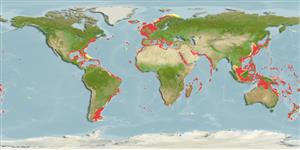Dipolydora armata (Langerhans, 1880)
| Native range | All suitable habitat | Point map | Year 2050 |

|
| This map was computer-generated and has not yet been reviewed. |
| Dipolydora armata AquaMaps Data sources: GBIF OBIS |
muatnaik fotos/gambar
imej Google |
No photo available for this species.No drawings available for Spionidae.
imej Google |
No photo available for this species.
Classification / Names Common names | Synonyms | CoL | ITIS | WoRMS
Polychaeta | Spionida | Spionidae
Environment: milieu / climate zone / depth range / distribution range Ekologi
; kisaran kedalaman 0 - 300 m (Ref. 107990). Tropical
Penyebaran Negara-negara | Daerah-daerah FAO | Ecosystems | Kemunculan | Introduksi
Western Indian Ocean, Atlantic Ocean and the Mediterranean Sea: Central America to northern Brazil.
Length at first maturity / Size / Weight / umur
Maturity: Lm ? range ? - ? cm
Life cycle and mating behavior Kematangan | Reproduksi, perkembang biakan | Pemijahan | telur-telur | Fecundity | Larva
Members of the class Polychaeta are mostly gonochoric (sexual). Mating: Females produce a pheromone attracting and signalling the males to shed sperm which in turn stimulates females to shed eggs, this behavior is known as swarming. Gametes are spawned through the metanephridia or body wall rupturing (termed as "epitoky", wherein a pelagic, reproductive individual, "epitoke", is formed from a benthic, nonreproductive individual, "atoke"). After fertilization, most eggs become planktonic; although some are retained in the worm tubes or burrowed in jelly masses attached to the tubes (egg brooders). Life Cycle: Eggs develop into trocophore larva, which later metamorph into juvenile stage (body lengthened), and later develop into adults.
rujukan utama
Acuan | Koordinator | mitra
Bisby, F.A., M.A. Ruggiero, K.L. Wilson, M. Cachuela-Palacio, S.W. Kimani, Y.R. Roskov, A. Soulier-Perkins and J. van Hertum. 2005. (Ref. 19)
Status IUCN Red List (Ref. 130435: Version 2024-1)
status CITES (Ref. 108899)
Not Evaluated
CMS (Ref. 116361)
Not Evaluated
ancaman kepada manusia
penggunaan manusia
| FishSource |
Alat, peralatan
informasi lanjut
Trophic Ecology
Ecology
Population dynamics
Pertumbuhan
Umur / Saiz
panjang-berat
panjang-panjang
ukuran frekuensi
Mass conversion
pemulihan
Kelimpahan
Umur / Saiz
panjang-berat
panjang-panjang
ukuran frekuensi
Mass conversion
pemulihan
Kelimpahan
Life cycle
Reproduksi, perkembang biakan
Kematangan
Fecundity
Pemijahan
telur-telur
pekembangan telor
Larva
Dinamika larva
Kematangan
Fecundity
Pemijahan
telur-telur
pekembangan telor
Larva
Dinamika larva
Distribution
Human Related
profil budidaya air
Stamps, Coins Misc.
Stamps, Coins Misc.
Outreach
Taxonomy
References
Sumber internet
BHL | BOLD Systems | CISTI | DiscoverLife | FAO(Publication : search) | Fishipedia | GenBank (genom, Nukleotida) | GloBI | Gomexsi | Google Books | Google Scholar | Google | PubMed | Tree of Life | Wikipedia (pergi, Cari) | Zoological Record
Estimates based on models
Preferred temperature
(Ref. 115969): 13.4 - 27, mean 18.2 (based on 293 cells).
kategori harga
(Ref. 80766):
Unknown.


